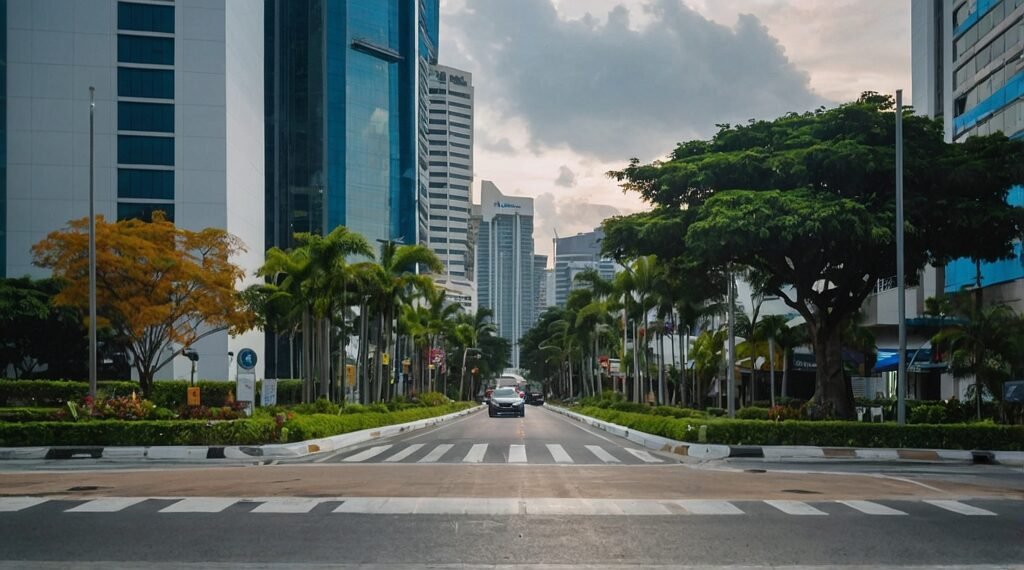The Philippines, an archipelagic nation in Southeast Asia, has experienced rapid urbanization over the past few decades. This process has transformed the country’s landscape, economy, and society in profound ways. Urbanization, defined as the increasing concentration of population in urban areas, has brought both opportunities and challenges to the Philippines. This blog post will explore the growth of urbanization in the country, its driving factors, and the multifaceted challenges it presents. We will delve into the historical context, current trends, and future projections of urban development in the Philippines, as well as examine the social, economic, and environmental implications of this ongoing transformation.
Historical Context of Urbanization in the Philippines
Pre-colonial era to Spanish colonization
The process of urbanization in the Philippines has roots that extend far back into history. In the pre-colonial era, the archipelago was home to numerous small settlements and trading posts, with some larger population centers developing around important political and economic hubs. The arrival of Spanish colonizers in the 16th century marked a significant turning point in the urbanization of the Philippines. The Spanish established a centralized colonial administration, focusing on Manila as the capital and primary urban center. This period saw the development of a network of towns and cities, often built around churches and government buildings, which laid the foundation for the country’s urban hierarchy.
American colonial period and post-independence urbanization
The American colonial period, which began in 1898, brought further changes to the urban landscape of the Philippines. The Americans introduced modern urban planning concepts, expanded infrastructure, and promoted education, all of which contributed to accelerated urban growth. Cities like Manila, Cebu, and Davao experienced significant expansion during this time. After gaining independence in 1946, the Philippines continued on its path of urbanization, driven by industrialization, internal migration, and natural population growth. The post-war period saw the rapid development of urban areas, particularly in and around Manila, as the country sought to modernize and develop its economy.
Current Trends in Philippine Urbanization
Urban population growth
The Philippines has experienced a steady increase in its urban population over the past several decades. According to data from the Philippine Statistics Authority (PSA), the urban population has grown from approximately 31.8% of the total population in 1960 to 51.2% in 2020. This trend reflects a significant shift in the country’s demographic composition, with more Filipinos now living in urban areas than in rural regions.
To illustrate this trend, let’s look at the following table:
| Year | Urban Population (%) | Rural Population (%) |
|---|---|---|
| 1960 | 31.8 | 68.2 |
| 1980 | 37.5 | 62.5 |
| 2000 | 48.0 | 52.0 |
| 2020 | 51.2 | 48.8 |
Urban primacy and metropolitan expansion
One of the key features of urbanization in the Philippines is the phenomenon of urban primacy, where a single city or metropolitan area dominates the urban hierarchy. In the case of the Philippines, this is exemplified by Metro Manila, which comprises the National Capital Region (NCR) and surrounding areas. Metro Manila is not only the political and economic center of the country but also the largest urban agglomeration, with a population of over 13 million as of 2020. The expansion of Metro Manila has led to the development of adjacent regions, creating an extended urban corridor that includes parts of Central Luzon and CALABARZON (Cavite, Laguna, Batangas, Rizal, and Quezon).
Emergence of secondary cities
While Metro Manila continues to dominate the urban landscape, there has been a noticeable trend towards the growth of secondary cities across the Philippines. Cities such as Cebu, Davao, Iloilo, and Cagayan de Oro have experienced significant urbanization in recent years. These emerging urban centers are becoming important regional hubs for economic activity, education, and cultural development. The growth of these secondary cities is contributing to a more distributed pattern of urbanization across the archipelago, potentially alleviating some of the pressure on Metro Manila.
Driving Factors of Urbanization in the Philippines
Economic opportunities and industrialization
One of the primary drivers of urbanization in the Philippines has been the concentration of economic opportunities in urban areas. Cities, particularly Metro Manila and other major urban centers, have become hubs for industrial development, service sector growth, and foreign investment. The promise of higher wages and better job prospects has drawn millions of Filipinos from rural areas to cities. The shift from an agriculture-based economy to one increasingly dominated by industry and services has accelerated this trend, as urban areas offer more diverse employment opportunities across various sectors.
Rural-urban migration
Rural-urban migration has been a significant factor in the rapid urbanization of the Philippines. Push factors in rural areas, such as limited economic opportunities, lack of access to quality education and healthcare, and in some cases, environmental degradation or natural disasters, have prompted many rural residents to seek better prospects in cities. Concurrently, the pull factors of urban areas, including perceived economic advantages, better infrastructure, and access to modern amenities, have attracted migrants from rural regions. This internal migration has contributed substantially to urban population growth and the expansion of urban areas.
Natural population increase
In addition to migration, natural population increase within urban areas has played a crucial role in driving urbanization. Urban populations in the Philippines have generally maintained higher fertility rates compared to more developed countries, although these rates have been declining in recent years. The combination of relatively high birth rates and improving healthcare leading to lower mortality rates has resulted in significant natural population growth in urban areas. This natural increase, coupled with ongoing migration, has fueled the expansion of cities and the transformation of peri-urban areas into more densely populated urban zones.
Government policies and urban development initiatives
Government policies and urban development initiatives have also played a role in shaping urbanization patterns in the Philippines. Various national development plans and strategies have focused on urban growth as a means of economic development. For instance, the creation of special economic zones, often located in or near urban areas, has encouraged industrial development and urban expansion. Additionally, infrastructure projects, such as the improvement of transportation networks linking rural areas to urban centers, have facilitated easier movement of people and goods, indirectly supporting urbanization.
Challenges of Rapid Urbanization in the Philippines
Housing shortages and informal settlements
One of the most pressing challenges arising from rapid urbanization in the Philippines is the severe housing shortage, particularly for low-income urban residents. The inability of formal housing markets to keep pace with population growth has led to the proliferation of informal settlements, often referred to as “slums” or “squatter areas.” These settlements are characterized by substandard housing, lack of basic services, and insecure land tenure. According to the World Bank, as of 2018, approximately 4.5 million people in the Philippines lived in informal settlements, with a significant concentration in Metro Manila.
The table below illustrates the estimated number of informal settler families in select urban areas:
| Urban Area | Estimated Number of Informal Settler Families |
|---|---|
| Metro Manila | 584,425 |
| Cebu City | 35,000 |
| Davao City | 30,000 |
| Iloilo City | 15,000 |
| Cagayan de Oro | 12,000 |
Infrastructure and service delivery challenges
The rapid pace of urbanization has often outstripped the capacity of local governments and service providers to deliver adequate infrastructure and basic services. Many urban areas in the Philippines face challenges in providing sufficient water supply, sanitation facilities, electricity, and waste management services to their growing populations. Traffic congestion is a major issue in many cities, particularly in Metro Manila, where inadequate public transportation systems and road networks struggle to cope with increasing vehicle ownership and daily commuter flows.
Environmental degradation and natural disaster risks
Urbanization has contributed to significant environmental challenges in the Philippines. The conversion of agricultural land and natural habitats to urban use has led to loss of biodiversity and ecosystem services. Urban areas also face issues of air and water pollution, with many cities exceeding World Health Organization (WHO) guidelines for air quality. Furthermore, the Philippines’ geographical location makes it vulnerable to natural disasters such as typhoons, floods, and earthquakes. The concentration of population and assets in urban areas, often in hazard-prone locations, has increased the potential for catastrophic losses from these events.
Social inequalities and urban poverty
While urbanization has brought economic opportunities to many, it has also exacerbated social inequalities in the Philippines. Urban poverty remains a significant challenge, with many city dwellers struggling to access decent housing, healthcare, and education. The stark contrast between affluent neighborhoods and informal settlements within the same city highlights the depth of urban inequality. According to the Philippine Statistics Authority, as of 2018, the poverty incidence in urban areas was 9.3%, compared to 24.5% in rural areas. However, this lower urban poverty rate masks significant variations within cities and the unique challenges faced by the urban poor.
Economic Implications of Urbanization
Contribution to economic growth
Urbanization has been a key driver of economic growth in the Philippines. Urban areas, particularly Metro Manila and other major cities, contribute disproportionately to the country’s Gross Domestic Product (GDP). The concentration of economic activities, human capital, and infrastructure in urban centers has facilitated increased productivity and innovation. According to the Philippine Statistics Authority, the National Capital Region alone accounted for 32.4% of the country’s GDP in 2020, highlighting the economic significance of urban areas.
Employment generation and labor market dynamics
Urban areas in the Philippines have become important centers for employment generation, offering a wide range of job opportunities across various sectors. The shift towards a more service-oriented economy has been particularly pronounced in cities, with sectors such as business process outsourcing (BPO), retail, and finance experiencing significant growth. However, the urban labor market also faces challenges, including underemployment, informal employment, and skills mismatches between job seekers and available positions.
Urban-rural economic linkages
Urbanization has also influenced rural economies through various linkages. Remittances from urban workers to their rural families have become an important source of income for many rural households. Additionally, urban demand for agricultural products has created market opportunities for rural producers. However, the rapid growth of cities has also led to the loss of agricultural land in peri-urban areas, potentially affecting food security and rural livelihoods.
Government Responses and Policy Initiatives
National urban development policies
The Philippine government has implemented various policies and programs to address the challenges of urbanization and promote more sustainable urban development. The National Urban Development and Housing Framework (NUDHF) provides a comprehensive policy framework for guiding urban growth and addressing urban issues. Key focus areas include improving urban planning, enhancing urban governance, promoting inclusive housing, and building resilient urban communities.
Decentralization and local governance
The Local Government Code of 1991 marked a significant step towards decentralization in the Philippines, devolving many urban management responsibilities to local government units (LGUs). This shift has aimed to empower local authorities to respond more effectively to urban challenges and tailor development strategies to local needs. However, implementation has been uneven, with many LGUs struggling with limited resources and technical capacity.
Housing and resettlement programs
To address the housing shortage and improve living conditions for urban poor communities, the government has implemented various housing and resettlement programs. These include in-city relocation projects, community mortgage programs, and initiatives to upgrade informal settlements. The National Housing Authority (NHA) and the Social Housing Finance Corporation (SHFC) are key agencies involved in these efforts. Despite these initiatives, the scale of the housing challenge remains significant, and there is ongoing debate about the effectiveness and sustainability of different approaches.
Future Prospects and Sustainable Urban Development
Projected urbanization trends
The urbanization trend in the Philippines is expected to continue in the coming decades. The United Nations projects that by 2050, approximately 65% of the Philippine population will reside in urban areas. This ongoing urbanization will likely see the further growth of existing urban centers and the emergence of new urban areas, particularly in regions outside of Metro Manila.
Here’s a projection of urban population growth in the Philippines:
| Year | Projected Urban Population (%) |
|---|---|
| 2030 | 56.3 |
| 2040 | 61.0 |
| 2050 | 65.0 |
Smart cities and technological innovation
The concept of “smart cities” is gaining traction in the Philippines as a potential solution to urban challenges. This approach involves leveraging technology and data to improve urban management, service delivery, and quality of life. Several cities, including Manila, Cebu, and Davao, have begun implementing smart city initiatives, such as intelligent traffic management systems, e-governance platforms, and digital payment systems for public services. While these initiatives show promise, their successful implementation will require significant investment in infrastructure and capacity building.
Climate change adaptation and urban resilience
Given the Philippines’ vulnerability to climate change and natural disasters, building urban resilience is a critical priority for sustainable urban development. This involves not only improving disaster preparedness and response mechanisms but also integrating climate adaptation measures into urban planning and infrastructure development. Green infrastructure, nature-based solutions, and climate-resilient building practices are increasingly being considered in urban development strategies.
Inclusive urban development
Addressing urban inequality and promoting inclusive growth remains a key challenge for the future of Philippine cities. Efforts to improve access to affordable housing, quality education, healthcare, and economic opportunities for all urban residents will be crucial. This may involve innovative approaches to urban planning, such as mixed-income housing developments, participatory budgeting processes, and targeted programs to support vulnerable urban populations.
Conclusion
Urbanization in the Philippines has been a transformative force, reshaping the country’s physical landscape, economy, and society. While it has brought significant opportunities for economic growth and development, it has also presented formidable challenges in terms of housing, infrastructure, environmental sustainability, and social equity. As the country continues on its urbanization trajectory, addressing these challenges will be crucial for ensuring sustainable and inclusive urban development.
The future of urbanization in the Philippines will likely be shaped by a complex interplay of demographic trends, economic forces, technological innovations, and policy choices. Balancing the need for continued urban growth with environmental sustainability and social inclusivity will be a key challenge for policymakers, urban planners, and citizens alike. By learning from past experiences, leveraging new technologies, and fostering collaborative approaches to urban governance, the Philippines has the potential to create more livable, resilient, and prosperous urban communities for future generations.
As cities continue to grow and evolve, the choices made today will have long-lasting impacts on the quality of life for millions of urban dwellers in the Philippines. Embracing sustainable urban development principles, promoting inclusive growth, and building resilience to climate change and natural disasters will be essential in shaping a positive urban future for the country.
Disclaimer: This blog post is based on available data and information as of the time of writing. While every effort has been made to ensure accuracy, urban dynamics are complex and rapidly changing. Readers are encouraged to consult the latest official statistics and reports for the most up-to-date information. If you notice any inaccuracies in this post, please report them so we can promptly make corrections.




